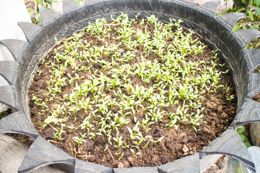By growing potatoes in tires, you don't only put a few old tires to good use, but also give your garden a unique look. With the help of these easy instructions, you'll have ready-to-use potatoes in a few months―fresh out of your own garden!

Growing potatoes is not a difficult job at all. There are a few things you need to consider though. The area in your garden where you plan to plant the potatoes, should receive at least 6-7 hours of sunlight. The soil should be rich, fertile, and incorporated with a lot of organic matter. Ensure that your soil's pH level is 6.5 or lower. Three tires are needed to maintain a proper height for growing potatoes. Let's begin with the procedure now.
Instructions
Procure some good quality seed potatoes. After you get them, a week or so prior to planting, induce sprouting in potatoes by putting them in a warm, well-lit area. Soon enough, you would see buds coming out from each eye of the potato. Then, cut the potatoes in large chunks, each chunk having at least one 'eye'.
Once you are settled with the tires, decide upon a place for the tire in your garden. Just remember that the soil should be warm and there should be a good amount of sunlight. So, pick the spot depending on that. When you decide upon a spot, also see whether you can have a proper drainage below the tire.
If all the tires are not of the same size, determine which is the biggest and lay it down first. This acts like a base. Now, fill the tire with soil. Plant your potato seeds in this tire, keeping a little distance between each chunk. Plant a maximum of three chunks. Add another tire and lay the soil around the stalk once the plant is around 8 inches tall. To avoid suffocation of the plant, leave a few inches uncovered. Repeat this process after the shoot grows 8 inches further. Don't place all the tires at once.
Now that you have planted the potatoes, water the taters well and ensure a thorough drainage of water. Water the seeds a bit more than usual immediately after planting, when it is in the flowering mode. If possible, do this in the morning, because if the leaves stay damp overnight, they are more prone to diseases. By the end of summer, when the foliage would turn brown and die back, stop watering. But, the harvest time has not yet arrived; there is still time for your potatoes to be ready for that. Before the commencement of the initial showers of rain, harvest the taters, or else they would rot in the ground. Post the procedure of gigging them up, keep them in a dry place.
Watering the plant regularly in the mornings is very important. The first time you grow potatoes, it might be a little difficult to gauge the watering time, the soil adding time, and the harvest time. However, the second time onward, you'll know exactly what you're dealing with.






 Growing potatoes is not a difficult job at all. There are a few things you need to consider though. The area in your garden where you plan to plant the potatoes, should receive at least 6-7 hours of sunlight. The soil should be rich, fertile, and incorporated with a lot of organic matter. Ensure that your soil's pH level is 6.5 or lower. Three tires are needed to maintain a proper height for growing potatoes. Let's begin with the procedure now.
Growing potatoes is not a difficult job at all. There are a few things you need to consider though. The area in your garden where you plan to plant the potatoes, should receive at least 6-7 hours of sunlight. The soil should be rich, fertile, and incorporated with a lot of organic matter. Ensure that your soil's pH level is 6.5 or lower. Three tires are needed to maintain a proper height for growing potatoes. Let's begin with the procedure now.